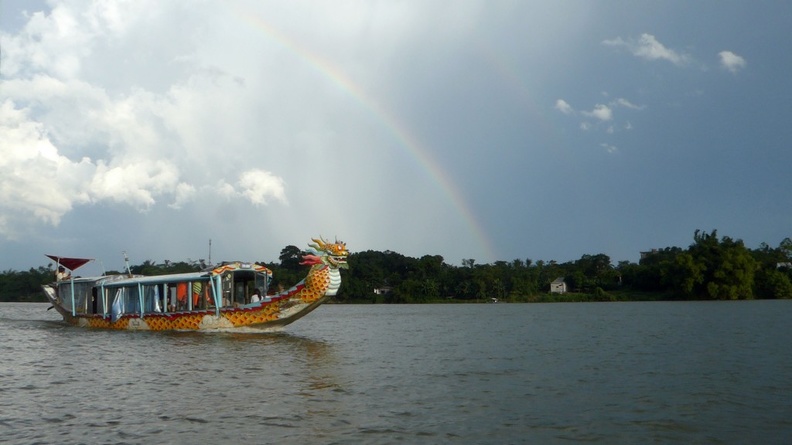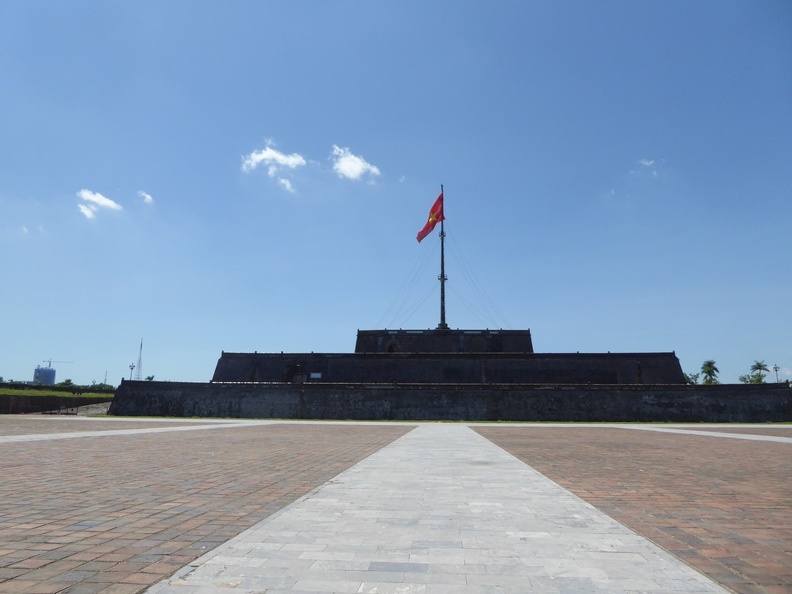The city of Huế (pronounced Hwe) is a city that was the seat of Nguyen Dynasty emperors and the national capital of Vietnam from 1802–1945. It is located in the Thua Thien Hue province in Central Vietnam. Geographically, the central Vietnamese city is well connected to other major cities in the country. Previously we looked at the majestic Phong Nha Ke Bang River Caves, today, lets check out the Hue City, Imperial Citadel and Forbidden City, Vietnam.
Hue is situated 700 km south of Hanoi, 1100km north of Ho Chi Minh City, and only a few miles from the sea. It is strategically located on the bank of Song Huong, otherwise known as the Perfume River. Morever, besides being the national capital till 1945, Hue is also the political, cultural and religious center of Vietnam under the control of Nguyen Dynasty.
Upon arrival at Phu Bai International Airport, the city is noticeably in contrast is more modern and has better infrastructure than the north in Hanoi. Notably, the roads and pavements are better made and so are the building infrastructures as a whole.
Hue, a city of history and beauty
Furthermore, the city is home to a population of about 350 thousand people. Hue had been recognized as one of the World Heritage Sites by UNESCO. This is given the number of historical architecture littered throughout the city. If you are into history and love discovering exotic cultures, the city of Hue former Royal Capital here is definitely on the top list of your travel plan during your stay in central Vietnam.
The city of Hue represents the outstanding demonstration of the vanished Vietnamese feudal empire. Today, an assortment of well-persevered and restored complex of monuments remains. In a nutshell, this comprises of tombs, palaces and pagodas that remains to tell the tales of the days past. Incidentally, these are also main attractions in Hue for tourists all over the world. Also, the Perfume river is a highlight of the city. It runs through the entire city is 30km long. The beautiful river is fed from Bằng Lãng river to the Thuan river as an estuary.

Shopping and Nightlife
Across the perfume river is where most of Hue’s city commerce resides, home to a number of commercial and residential districts. Shopping areas in Hue is adequate, but not fantastic. It comprises of a number of departmental stores and family owned stores in the busy parts of town. However, it is history and not shopping for what you should visit the city of Hue for.
Also, there are not as many shopping locations in Hue as say compared to Hanoi or Ho Chin Min. However, there are notable shopping and pedestrian streets at Phạm Ngũ Lão and Võ Thị Sáu streets. Additionally, these streets are lined with pubs and stores catering to tourists, particularly targeted to much to western tastes. This encompasses much of the night life in the city.
Like most parts of Vietnam, most shop businesses are family owned stores. Hence, it is not uncommon to see a shop front residing on the ground floor with living quarters above. Also, when shopping for clothing or bags, keep in mind never go about accepting any initial offer prices. Moreover, you can easily strike a deal of 100,000 dong for “branded” sportswear which are sold everywhere here in Vietnam.
Hue Citadel and Forbidden Purple City
A major landmark dominating most part of the city is its vast, 19th-century Citadel. Moreover, it is distinguished by its military-like fortress constructed out of brick and stone surrounded by a moat.

It is situated just by the city’s Huong (Perfume) River which fuels the country early transport and trade. Also, it is not uncommon to see many of the water moat features surrounding the citadel transformed into small Lilly ponds bearing fishes and eateries.
In the inner citadel grounds
However, in June 1789 Nguyễn Ánh took control of Vietnam and proclaimed himself Emperor Gia Long. With construction started in 1804. The formidable citadel wall encompasses the entire Imperial Forbidden City, shielding the palaces and shrines of the Forbidden Purple City within from the outer city. Today, the inner citadel grounds are all publicly accessible via multiple small pedestrian road entrances and occasionally at strategic points. This includes vehicular entrances large enough for at least a bus to pass through.
Furthermore, two layers of walls separate the outer citadel walls from the inner. These intermediate grounds are vast, with many open green spaces such as fields, currently these are home to residential and commercial business comprising of small micro towns built in the citadel compound which mainly serve the tourist population visiting the Forbidden Purple City.
Sitting in front of the city entrance is a large gathering space. This presumably was previously used as a military form up and barracks area, especially a place large enough to round up and gather troops and their cavalry. Notably, this includes not only horse, but war elephants too. Also, a couple of defensive cannons can also be seen still sitting in this inner areas of the citadel grounds.
Inside the Hue Forbidden City
Large Meridian imperial gates and a giant Citadel flagpole bearing the Vietnam flag greets you at the entrance of the Citadel. Moreover, the outer walls of the Citadel are built solidity like a fortress. Moreover, upon entering the compound, a bridge leads you directly to the Hall of Supreme Harmony, which serves as an a royal Throne.

Furthermore, the citadel was featured in various Asian songs and poems, given its historical significance. Historically, the original citadel grounds occupy a large, bounded area on the north side of Perfume River. Moreover, it comprises of four separate citadels each with its own district to create the Capital City. Notably, this is known by the locals as Hoang Thanh, or Imperial City in English.
Here, the inner grounds of the city consists of an assortment of royal palaces, buildings and shrines. Notably, these were used for official business, such as the equivalent of a parliament as well as living quarters for the king, an army and supporting servants.
Entrance to the Hall of Supreme Harmony
Ruins of the forbidden city
Noteworthy, most of the actual palace grounds had been destroyed in the Vietnam war. Also, more than half of the Purple Forbidden City grounds were being left in ruins from the war. However, most of the destruction which ensued after was mostly caused by post-war neglect. Notably, this includes lack of upkeep, weather elements (e.g. cyclone damage), and pests (e.g. termites).
Hence, today only a quarter of the full citadel compound is left to be preserved as a museum and attraction. The other districts here are leveled and opened for mixed residential and commercial developments by the locals today.
Key buildings such as The king’s quarters, known as Tu Cam Thanh (Forbidden Purple City) for royal residences which once as the emperor’s home. Today, these are all nicely restored as close as what they were before. Moreover, this area is centrally located past the compounds into the Inner city (or Dai Noi). Also, the front of the Forbidden city was also nicely restored to as close as what it was as depicted in early black and white photographs records.
Panorama of the forbidden city and ruins in the distance
Moving beyond the majestic Thai Hon Palace is another central courtyard. Also, this open space is flanked by two houses. These were also restored and houses a collection of painting and photos plastered on the inner walls of the houses. Today, one of these houses open activity areas, a giftshop and photo shoot areas and a museum in the other.
Ruins of the Forbidden city
Additionally, like the king’s quarters, from this point on, most of the Forbidden city living quarters and the buildings had been totally destroyed in the various Vietnam wars. Consequentially, what remained here are building ruins littered all over. Notably, the Tran Binh Dai, a garrison fortress is known exclusively here for its ancient architecture still existing today. Additionally, a rebuilt replica of the Royal Theater can also be found within the compound just across a large field clearing just by the royal residences.

Here, you can find two long wooden hallways lined with walls of photographs, scriptures and lanterns. Moreover, these details were all painstakingly recreated to what it historically was. Altogether, this offers an eccentric mix of newly constructed era-accurate buildings right next to the original stone ruins. Gracefully, these hallways run from the Mandarins houses towards the end of the attraction palace grounds before ending at a large open garden.
Beautiful walkways
Additionally, the walkways are nicely painted in dark red lacquered on wood with gold trimmings. These wooden doors are made in a traditional oriental style with slatted windows. They swings outwards into the beautiful gardens beyond. Also, these doors are designed to provide and facilitate convection cooling on hot days.
Commendably, this was an engineering marvel especially in an era without air-conditioning. Paper lanterns are hung at regular intervals throughout the courtyard walkway for artificial illumination, especially at night.

Sadly, the palace grounds today are reduced to the quarter of it’s original size. Here, the pathway ends with a lush garden and an altar flanked by two octagonal pavilions and two stone dragons. Moving on by these stone dragons is a flight of staircases leading up to a larger golden dragon statue. Also, up here, you can have a good view of the what remains of the forbidden palace grounds today.
Furthermore, walking is the recommend mode of transport within the Forbidden City. Also, you can navigate them through the number of interlinking stepped walkways connecting the various buildings of interest. Moreover, the route is still largely wheelchair accessible, though you might not be able to access most buildings given the high step-in height at the entrances.

In conclusion, Hue has enough charm to keep you staying as long as you can afford the time to visit. All in all, a visit to the Forbidden City can set you back at least half a day, it is advisable to visit near the mornings where it is not so hot.
Check out more photos of the Forbidden City in Hue here.





























